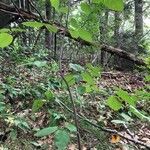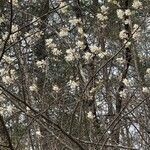Much like no. 9 [Amelanchier laevis Wiegand], seldom only 2 m tall; lvs typically oblong-obovate, much less than half-grown at anthesis, densely pubescent beneath when young, not (or scarcely) coppery, usually glabrous or nearly so at maturity; pedicels shorter, mostly not over 2 cm even in fr, often silky; sep 2–3 mm; pet (10–)12–15+ mm; ovary glabrous at the summit, varying to occasionally somewhat tomentose; fr dark red-purple, tending to be dry and insipid; mostly diploid. Dry or rocky upland woods; Me. and N.B. and s. Que. to sw. Ont. and Minn., s. to Ga., nw. Fla., La., and e. Okla. (A. arborea var. cordifolia)
A deciduous tree. It grows to 10 m tall and spreads to 12 m wide. The crown is narrow. The lower branches droop. The bark is grey and smooth when young and becomes ridged and scaly with age. The leaves are oval and 7.5 cm long and 4 cm wide. The leaves have fine teeth. The leaves are rounded and heart shaped at the base and pointed at the tip. They are covered with white down as they emerge. The leaves turn red, orange or yellow in autumn. The flowers occur in profuse upright sprays. The fruit are borne in small clusters and are 10 mm across.



